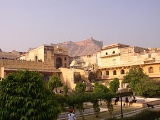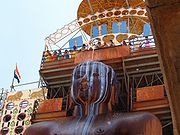
Digambar Terapanth
Encyclopedia
The Adhyatma movement among the Jains arose in 1626 AD (1683 in the Vikram Samvat calendar) in Agra
. Its leading proponent was Banarasidas
of Agra
. Adhyatma groups flourished during 1644-1726 in Agra, Lahore and Multan. While the movement was based on the books written by Acharya Kundakunda
, most of its followers were of Shwetambar sect. It represents an interaction of the Digambara and Shwetambar sects. Later it indirectly influenced the emergence of Terapanth. Poet Dyanatrai was associated with the Adhyatma movement.
 The Bispanthi/Terapanth
The Bispanthi/Terapanth
i divisions among the Digambara
Jains emerged in 17th century in Jaipur region (Sanganer, Amber and Jaipur itself).
Terapanth was founded by Amra Bhaunsa Godika and his son Jodhraj Godika during 1664-1667, who were prominent citizens in Sanganer, who expressed opposition to the Bhattaraka
Narendrakirti of Amber. Authors Daulatram Kasliwal and Pandit Todarmal
(author of Moksh Marg Prakashak
) were associated with the Terapanth movement.
The Digambra Terapanth movement was against the domination of the Bhattaraka
s. They opposed worship of various minor gods and goddesses. Some Terapanthi practices, like not using flowers in worship, gradually spread throughout North India among the Digambaras.
The Digambara Jains who have continued to follow older practices are termed Bis-panthi. Most Digambar Jains do not identify themselves as being exclusively Terapanthi or Bispanthi.
Bakhtaram in his "Mithyatva Khandan Natak" (1764) mentions that group that started it included 13 individuals, who collectively built a new temple, thus giving it its name Tera (13) Panth. However according to "Kavitta Terapanth kau" by an unknown Chanda Kavi, the movement was named Tera Panth, becuae the founders disagreed with the Bhattaraka on 13 points. A letter of 1692 from Tera Panthis at Kama to those at Sanganer mentions 13 rituals practices rejected.
The Terapanthis reject these practices:
Mentioned in Buddhivilas (1770) of Bakhtaram:

The letter by Tera Panthis at Kama also mentions:
Terapanth Khandan of Pandit Pannalal also mentions:
In 20th century, the people who led the movement are:
1. Srimad Rajchandra, who started Shrut Prabhavak Mandal. The Mandal was responsible for translating a lot of Digambar Jain Scriptures in
modern indian languages. He also wrote many poems and proses and refers the "Terapanth Digambar" as "Mool Maarag" ( The Root cause of Liberation) in his work.
2. Kanji Swami
3. Champaben, Chief disciple of Kanji Swami.
4. Shantaben, Chief disciple of Kanji Swami.
5. Pandit Himmatlal Jethalal Shah, who translated Samaysar, Pravachansar, Panchastikay and Niyamsar Scriptures into Gujarati Language in Prose form as well as Poetic form.
6. Brahmachari
Pandit Vrajlal Girdhrlal Shah, who translated Purusharth Siddhi Upai and Dravya Sangrah into Gujarati Language.
7. Pandit Hukumchand Bharril, who started Todarmal Smarak Trust, and was instrumental in translation and study of many Digambar Jain Scriptures.
Agra
Agra a.k.a. Akbarabad is a city on the banks of the river Yamuna in the northern state of Uttar Pradesh, India, west of state capital, Lucknow and south from national capital New Delhi. With a population of 1,686,976 , it is one of the most populous cities in Uttar Pradesh and the 19th most...
. Its leading proponent was Banarasidas
Banarasidas
Banarasidas was a Shrimal Jain businessman and poet of Mughal India. He is known for his poetic autobiography - Ardhakathānaka, , composed in Braj Bhasa, an early dialect of Hindi linked with the region around Mathura. It is the first autobiography written in an Indian language...
of Agra
Agra
Agra a.k.a. Akbarabad is a city on the banks of the river Yamuna in the northern state of Uttar Pradesh, India, west of state capital, Lucknow and south from national capital New Delhi. With a population of 1,686,976 , it is one of the most populous cities in Uttar Pradesh and the 19th most...
. Adhyatma groups flourished during 1644-1726 in Agra, Lahore and Multan. While the movement was based on the books written by Acharya Kundakunda
Kundakunda
Kundakunda is a celebrated Jain Acharya, Jain scholar monk, 2nd century CE, composer of spiritual classics such as: Samayasara, Niyamasara, Pancastikayasara, Pravacanasara, Atthapahuda and Barasanuvekkha. He occupies the highest place in the tradition of the Jain acharyas.He belonged to the Mula...
, most of its followers were of Shwetambar sect. It represents an interaction of the Digambara and Shwetambar sects. Later it indirectly influenced the emergence of Terapanth. Poet Dyanatrai was associated with the Adhyatma movement.

Terapanth
Terapanth or Tera Panth may refer to:* Digambar Terapanth, a sect of the Digambara tradition of Jainism* Svetambar Terapanth, a sect of Svetambara Jainism-See also:Taran Panth, also a Digambar Jain sect, should not be confused with Terapanth...
i divisions among the Digambara
Digambara
Digambara "sky-clad" is one of the two main sects of Jainism. "Sky-clad" has many different meaning and associations throughout Indian religions. Many representations of deities within these traditions are depicted as sky-clad, e.g. Samantabhadra/Samantabhadrī in Yab-Yum...
Jains emerged in 17th century in Jaipur region (Sanganer, Amber and Jaipur itself).
Terapanth was founded by Amra Bhaunsa Godika and his son Jodhraj Godika during 1664-1667, who were prominent citizens in Sanganer, who expressed opposition to the Bhattaraka
Bhattaraka
A Bhaṭṭāraka is the head of traditional Jain institutions. They are responsible for training of scholars, maintenance of libraries, managing the endowments, presiding over the installation ceremonies and running of Jain institutions....
Narendrakirti of Amber. Authors Daulatram Kasliwal and Pandit Todarmal
Pandit Todarmal
Pandit Todarmal was an eminent Indian scholar on Jainism and writer in Jaipur.Pt. Todarmal had an organized system for preservation and study of Jain texts. About 10 to 12 copyists were engaged to make hand written copies of important texts in different parts of the country...
(author of Moksh Marg Prakashak
Moksh Marg Prakashak
Moksh Marg Prakashak is a book written by Pandit Todarmal. The book could not be completed by Todarmal due to his death and is thus incomplete after the middle of the ninth chapter. "Moksha marg prakashak" means the illuminator of the path to liberation. It is a polemic book written from the...
) were associated with the Terapanth movement.
The Digambra Terapanth movement was against the domination of the Bhattaraka
Bhattaraka
A Bhaṭṭāraka is the head of traditional Jain institutions. They are responsible for training of scholars, maintenance of libraries, managing the endowments, presiding over the installation ceremonies and running of Jain institutions....
s. They opposed worship of various minor gods and goddesses. Some Terapanthi practices, like not using flowers in worship, gradually spread throughout North India among the Digambaras.
The Digambara Jains who have continued to follow older practices are termed Bis-panthi. Most Digambar Jains do not identify themselves as being exclusively Terapanthi or Bispanthi.
Bakhtaram in his "Mithyatva Khandan Natak" (1764) mentions that group that started it included 13 individuals, who collectively built a new temple, thus giving it its name Tera (13) Panth. However according to "Kavitta Terapanth kau" by an unknown Chanda Kavi, the movement was named Tera Panth, becuae the founders disagreed with the Bhattaraka on 13 points. A letter of 1692 from Tera Panthis at Kama to those at Sanganer mentions 13 rituals practices rejected.
The Terapanthis reject these practices:
Mentioned in Buddhivilas (1770) of Bakhtaram:

- Authority of Bhattarakas
- Use of flowers, cooked food or lamps
- Abhisheka (panchamrita)
- consecretation of images without supervision by the representatives of Bhattarakas.
The letter by Tera Panthis at Kama also mentions:
- Puja while seated
- Puja at night
- Using drums in the temple
Terapanth Khandan of Pandit Pannalal also mentions:
- Worship of minor gods like dikpalas, shasan devis (PadmavatiPadmavati (Jainism)Padmāvatī is the protecting goddess or śāsanadevī of Pārśva, twenty-third Tīrthaṅkara in Jainism. She enjoys an independent religious life and is very popular amongst Jains. Padmāvatī is the main deity at Humbaj, the famous tirtha....
etc.) and Kshetrapal.
In 20th century, the people who led the movement are:
1. Srimad Rajchandra, who started Shrut Prabhavak Mandal. The Mandal was responsible for translating a lot of Digambar Jain Scriptures in
modern indian languages. He also wrote many poems and proses and refers the "Terapanth Digambar" as "Mool Maarag" ( The Root cause of Liberation) in his work.
2. Kanji Swami
Kanji Swami
1889-1980) was a Jain scholar, philosopher and spiritual leader. He was the founder of the Kanji Panth within the Digambar Jain tradition. He significantly influenced the practice of swadhyaya among the Jain laity....
3. Champaben, Chief disciple of Kanji Swami.
4. Shantaben, Chief disciple of Kanji Swami.
5. Pandit Himmatlal Jethalal Shah, who translated Samaysar, Pravachansar, Panchastikay and Niyamsar Scriptures into Gujarati Language in Prose form as well as Poetic form.
6. Brahmachari
Celibacy
Celibacy is a personal commitment to avoiding sexual relations, in particular a vow from marriage. Typically celibacy involves avoiding all romantic relationships of any kind. An individual may choose celibacy for religious reasons, such as is the case for priests in some religions, for reasons of...
Pandit Vrajlal Girdhrlal Shah, who translated Purusharth Siddhi Upai and Dravya Sangrah into Gujarati Language.
7. Pandit Hukumchand Bharril, who started Todarmal Smarak Trust, and was instrumental in translation and study of many Digambar Jain Scriptures.

